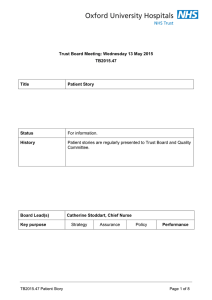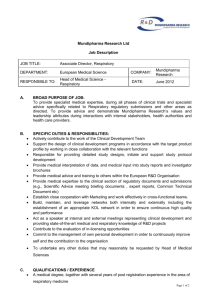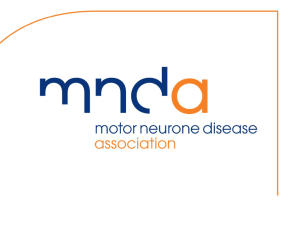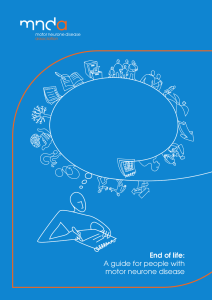Motor Neurone Disease
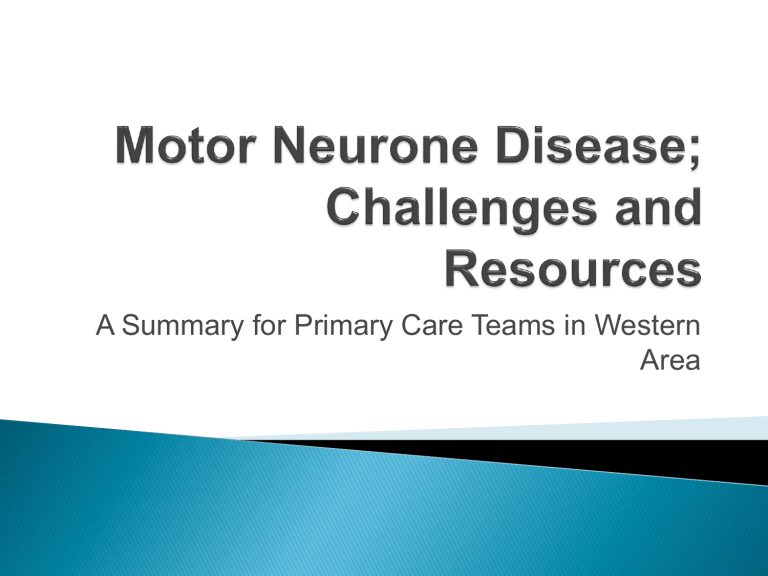
A Summary for Primary Care Teams in Western
Area
This resource is based on MNDA Scotland’s Paper:
Motor Neurone Disease, A Problem Solving
Approach. Available on http://www.mndscotland.org.uk/wpcontent/uploads/2011/08/A-Problem-Solving-
Approach-2012.pdf
Adapted for local use by:
Alison Dick MND Network Coordinator
Helen McClean MNDA Northern Ireland
Primary Palliative Care Team, WHSCT
Foyle Hospice Medical Team
Neurology Lead: Dr Colette Donaghy.
ColetteG.Donaghy@westerntrust.hscni.net
MND Network Coordinator: Ms Alison Dick. a lison.dick@belfasttrust.hscni.net
MND Association: Ms Helen Mc Clean helen.mcclean@mndassociation.org
•
•
•
•
•
•
•
Others, inc:
SALT
Dietetics
Specialist Palliative Care Community team
Physiotherapy
Respiratory Team
OT
Social worker
Progressive degeneration of motor neurones in the following areas:
Anterior horn cells - resulting in Lower Motor
Neurone Lesions (LMN)
Cortico spinal tract cells - resulting in Upper Motor
Neurone Lesions (UMN)
Cortico bulbar tracts – resulting in UMN lesions in areas controlling the oropharyngeal muscles
Motor Nuclei in brain stem - resulting in both
Upper and Lower Motor Lesions.
Four Main Patterns. Commonest is
1. Amyotrophic Lateral Sclerosis (65%)
• Begins in a limb, trunk or respiratory muscles.
• Both upper and lower motor neurones (UMN & LMN) may be involved
• Characterised by: muscle weakness, spasticity, hyperreflexia , emotional lability, fasciculations, weight loss.
• Usually progresses (80% of cases) to include progressive bulbar palsy symptoms.
• Average survival 2-5 years from onset of first symptoms.
2. Progressive Bulbar Palsy (PBP) A form of ALS Affects ~ 22% of all MND diagnoses.
UMN & LMN may be involved. Typified by dysarthria and dysphagia.
LMN damage: nasal speech, regurgitation of fluids via nose, tongue atrophy and fasciculation, pharyngeal weakness.
UMN damage: tongue spasticity, explosive dysarthria, emotional lability.
Slightly more women than men affected.
Average survival 6 months to 3 years from onset of symptoms
3. Progressive Muscular Atrophy (PMA) Affects about 10% of all MND diagnoses.
Defined as a disease of purely LMN degeneration, however a significant number of cases develop subclinical and, eventually, overt UMN signs.
Characterised by: muscle weakness, wasting, weight loss and fasciculation. Affects men 5 times more commonly than women.
Younger age of onset: average survival five years plus.
4. Primary Lateral Sclerosis (PLS)
Approximately 2% of all MND diagnoses.
Only upper motor neurones damaged. Characterised by muscle weakness, stiffness of limbs and increased reflex response. Men are affected twice as often as women.
Onset usually after 50 years of age:
Survival similar to normal life span.
Considerable overlap between 4 clinical syndromes outlined as disease progresses towards more generalised weakness.
Onset is insidious.
Early symptoms may include: stumbling, foot drop, weakened grip, slurred speech, cramp, muscle wasting and/or tiredness.
Rarely, presents with acute respiratory weakness.
1.Riluzole (Rilutek) is the only drug available to treat
MND. It was licensed in 1996 and NICE approval was obtained for the treatment of MND in 2001.
Riluzole acts by modulating the pre-synaptic release of glutamate.
2.A baseline respiratory assessment and discussion of future support options should be undertaken as soon as possible after diagnosis, by specialist team.
Mobility e.g. walking and balancing Physiotherapist
Swallowing Speech and Language Therapist
Weight loss, lack of appetite Dietician
Communication
Coughing
Speech and Language Therapist
Physiotherapist and Speech and Language Therapist
Breathlessness at rest or lying flat, sleep disturbances, daytime sleepiness, morning headaches, tired or lethargic or difficult to rouse. Respiratory consultant,
Respiratory physiotherapist, Specialist palliative care services
Fear, anxiety, depression Psychologist/counsellor/palliative care services
Uncontrolled pain Specialist palliative care services
Drooling and/or thick viscous mucus Physiotherapist for advice on positioning or District Nurse/GP for suction unit/cough assist, GP for medication
Difficulties in activities of daily living e.g. washing, dressing, cooking and leisure
Occupational Therapist or Social Worker
Support for individual and family Social Work, MNDA, MND Care Team, Local
Hospice Service, Northern Ireland Rare Disease Partnership , Faith communities,
Carer networks
1.Register patient on supportive/palliative care register, with key contact person.
2.Provide relationship based continuity as far as possible to patient and/or carer. (Monitoring and assessment)
3.Information gathering (give current and anticipatory information; liase with specialist teams)
4. Coordinate and refer as needed
5. Symptom management plans: coordinate, develop, share.
1.Patient identified as having MND/flagged on IT system
2.Carers identified and flagged.
3.Key contact people in primary and secondary care teams easily identifiable on IT system
4.OOH informed of diagnosis and key issues with frequent update
5.ACP/ ADRT decisions clearly communicated
6.DNACPR status identified and communicated to ambulance and
OOH
7.End of life care preferences communicated as and when appropriate.
1.Environment: Will home be suitable? Adaptations? (OT)
2.Changes in ability to speak/communicate/swallow? (SALT)
3.Respiratory Compromise: Ventilatory support? Home oxygen?
4.Loss of function (physiotherapy)
5.Emotional implications (psychology, support resources)
6.Care and respite needs? (Social work)
7. End of life (advance care planning, ADRT, DNACPR)
80% affected
Causes:
•
• Weakness & wasting of: Tongue lips facial muscles pharynx and larynx
Reduced palatal elevation, which can lead to
“hyper-nasal voice quality.”
• Reduced breath support, which can lead to reduced volume or “breathy” voice quality.
Impact:
Progressive difficulty with articulation, slurred speech and/or loss of volume. May lead to anarthria
Role of SALT:
Examine the patient’s range of movement in their lips, tongue and palate or will carry out an oromotor examination; Advise on communication strategies; Arrange for reassessment and provision of communication aids such as Lightwriters and other aids.
Role of OT :
Seating, positioning, wrist and head supports; Switches and pointers;
Mobile arm supports, tables to access communication aids;
Environmental controls.
Role of Everyone:
Take time and create a quiet relaxed atmosphere; Ascertain individual’s own preferred communication strategy and/or equipment used; Position face to face, watch lips, eyes, gestures.
Always be aware of the impact of emotion and fatigue on ability to communicate
Cause: Weakness and paralysis of the oropharyngeal muscles resulting from affected gIossopharyngeal, vagus, accessory and hypoglossal nerves.
Effect: The first sign of early dysphagia may be problems when swallowing liquids resulting in severe coughing.
This may progress to include: Loss of ability to form lip seal, chew, propel food with the tongue and/or form a bolus; Poor or absent swallow reflex; Weak pharyngeal muscles resulting in uncoordinated swallow; Failure to close airway; Muscle spasm; Acid reflux.
Resulting in Drooling; Dehydration and weight loss;
Aspiration and recurrent chest infection; Impaired respiratory function.
1.Food textures (SALT)
2.Fortification (Dietetics)
3.Head positioning and support (Physio)
4.Timing and quantity of food
5.Enteral feeding (PEG; RIG): can be used in combination with oral feeding; patient’s wishes should be sought at an early stage; (risks higher when illness progressed; weight loss affects prognosis)
6.Drooling/constipation (Prescribing)
Thin, runny saliva:
Suction
Tricyclic antidepressants such as: Amitriptyline
Hyoscine (butylbromide or hydrobromide) sublingually, S.C., 24 hour syringe pump; Transdermal patches
Glycopyrronium (Robinul)
(usually given PO or S.C. as intermittent injections or via a syringe pump).
Botox injection
Attention to head support and general posture - consult physiotherapist or
OT.
Thick tenacious saliva:
Check fluid intake, re-hydrate, avoid mouth breathing. Oral hygiene
- consult district nurse.
Proteases such as Papain or Bromelaine, from health food stores sprinkled on the tongue can help break down thick saliva.
Pineapple, papaya, apple or lemon juices or flavoured ice cubes can also help.
Nebulise: saline
Mucodyne (Carbocysteine)
Expectorants (e.g.)Robitussin
Tends to be due to forced inactivity, reduced peristalsis, low fluid intake, reduced fibre intake and/or weakness of pelvic floor/abdominal muscles, and use of analgesics.
Maintain hydration and fibre intake.
Treatment
Regular aperients:
Movicol sachet
Lactulose
Docusate
Sennoside B
Co-danthramer (where prognosis is limited).
Use of suppository, enemas, manual evacuation may be necessary on occasions.
Also remedies such as bulking agents, prunes, linseed etc. available over the counter.
Note : Diarrhoea may be due to constipation with overflow.
•
•
•
•
•
•
•
Major cause of anxiety.
•
•
Always review swallow
May lead to:
Fear, anxiety, panic & disturbed sleep;
Fatigue and reduced functional ability;
Daytime somnolence;
Poor appetite;
Vivid Dreams; Breathless with or without exertion;
Breathless when lying (orthopnoea);
Hypoxia or hypercapnia and possible confusion;
Inability to expectorate lung secretions.
Increased CO2 levels resulting in headaches, particularly on waking. Caution: O2 should be prescribed by specialist and used with caution (hypercapnia: use 28% O2 only until specialist assessment)
•
•
•
•
•
•
•
•
•
Consider:
Referral to a consultant in respiratory medicine early on, to explore options before respiratory problems become evident.
Involve the family;
Assisted ventilation;
Consider annual flu vaccination.
Referral to the palliative care team ;
Medication Use : Humidifier; Nebuliser;
Low dose beta blockers e.g. Metoprolol, Propranolol, to reduce production of lung secretions and thick tenacious saliva, mucus plugs (contra-indicated in asthmatics);
Carbocisteine – increase mucodyne to relieve symptoms – use with caution as patient’s cough is weak; Midazolam S.C. or buccal; Lorazepam; Diazepam;
Liquid morphine; Morphine Sulphate modified release tablets e.g.
MST, Zomorph; Diamorphine.
At each contact with the patient assess their breathing and ask about symptoms (as below).
Early referral to a respiratory specialist is vital if one or more of the following occur.
o o o o o o o o o Breathlessness on exertion or when lying flat; Shallow rapid breathing or use of accessory muscles on inspiration;
Weak cough/sniff;
Weak voice;
Sleep disturbances;
Unrefreshing sleep;
Daytime sleepiness;
Headaches on wakening;
Poor appetite/easily full;
Very tired/irritable/confused/drowsy.
National Guidelines on non-invasive ventilation http://guidance.nice.org.uk/CG105
Benefits
Improved quality of life through improved sleep, less troublesome symptoms during the day;
Increased survival;
Increased appetite.
Disadvantages
Risk of aspiration if control of oropharyngeal secretions is poor;
Skin breakdown if mask is used for long periods;
Inability to tolerate mask or use machine;
Less effective as MND progresses;
Increasing dependency over time, which may have inverse impact on quality of life;
Usually requires assistance of a carer and can increase the carer burden.
o Affects round half of sufferers o High index of suspicion. May lead to agitation or restlessness.
o Muscle spasm, neuropathic pain, joint pain, immobility, constipation or colic o Often requires a combination of agents o Re assess and adjust management often.
Significant issue for some but may be subtle.
Fronto temporal cognitive loss (loss of inhibition, rigidity, repetitive behaviour) affects 15% or more; changes may be mild.
Behavioural or mild personality change commonly reported.
Key issue
Major and progressive losses
Feelings of helplessness common
Fear of choking causes great anxiety
Watch for depression
Anticipate carer exhaustion and advise re self care.
Is someone helping the patient develop an advance care plan?
Do you need to involve a specialist palliative care service?
Have you discussed the situation with patient and family so they can prepare for what is likely to happen?
Have you continued to reassure the patient and family that, contrary to popular belief, death by choking or fighting for breath is not the norm?
Have you arranged for appropriate medications for the home to prevent a crisis admission?
Is there adequate physical and emotional support for the family if the person wishes to die at home?
Have you informed the ambulance service of any relevant advance planning, e.g. DNACPR?
Have you informed your local primary care out-of-hours service?
http://proforum.mndassociation.org
Forum for professionals
http://www.mndassociation.org/forprofessionals/Inf ormation+for+GPs/Online+learning+for+GPs.htm
Online courses



